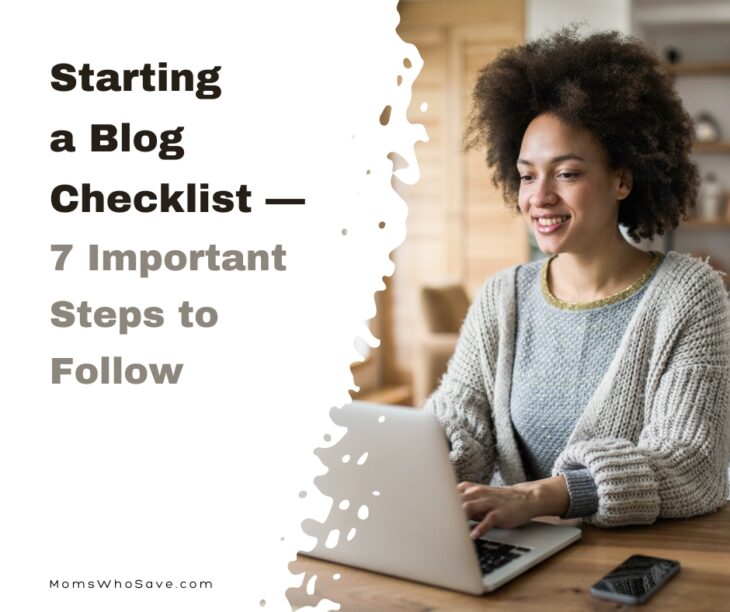Disclosure: Articles may contain affiliate links. As an Amazon Associate, we earn from qualifying purchases (at no additional cost to you). See our full disclosure here.
Last updated on December 12th, 2023 at 10:38 am

Is there a subject you’re deeply passionate about? Starting a blog can be a great way to turn your passion into a side hustle, or even a full-time career. But, if you have no clue how to start a website, even getting up and running can be completely overwhelming.
Believe me when I tell you that if you really want to do it, you can start a blog, and you can turn it into a money-maker. I should know! I started MomsWhoSave over 16 years ago, and with a lot of trial and error, and even more persistence, it became my full-time job.
One regret I have is that I didn’t have much guidance in those early months and years, so I wasted quite a bit of time on things that weren’t successful.
You don’t have to make those same mistakes. Keep reading for our easy-to-follow blog checklist.
Along with this list, you can find plenty of blogging groups on Facebook and how-to resources just by searching the internet.
All of these things will get you off to a good start on your blogging journey.

How to Start a Blog in 7 Steps
We’ve broken down all the steps to starting a blog. Even if you’re a total beginner, these tips for starting a blog will simplify the process.
Step 1: Define Your Brand
Here’s the fun part: defining your brand!
Choose a topic
You’ll need to find a good niche or blog topic that you are both interested in and that has a good search volume. For example, cryptocurrency has a lot of search volume right now, but if you’re not interested in it or knowledgable about it, it will be difficult to create content. So, look for a blog niche idea that will keep your interest.
Next, be aware that even if you find something with lots of search volume, you, as a new blogger, have to be able to compete for those views. For example, lots of people are looking for dessert recipes, but the “big” sites will inevitably beat you out in Google search when it comes to this topic.
So, can you narrow your focus? Maybe “gluten-free” desserts, “vegan” desserts, or “chocolate” desserts is better. Many people are likely searching for these phrases on Google, but there is less competition, so you stand a better chance of being seen.
And, finally, Google likes to see that you know what you’re writing about, so unless you’re very well-qualified, a medical or health niche can be difficult. Sites like WebMD, the Mayo Clinic, and hospitals will rank first for this type of content.
Research blogs in the same niche
Once you’ve found a topic that works, you’ll want to look at the most successful blogs on that topic.
You want to see what they’re doing, so you can offer something more, something different, or go more in-depth.
Taking a look at successful blogs in your chosen niche will also be a good reference when it comes to the aesthetics associated with your niche.

Brainstorm possible brand names
Once you’ve sized up your competition, it’s time to come up with some brand names. Write down as many as you can think of.
Then, look up the domain names before committing. You can also look to see if the social media handles are taken on Twitter, Facebook, Instagram, Facebook, etc. You don’t want to fall in love with a possible blog name only to find it’s been taken.
A side note about social media handles: it’s best to have your social media handles match your site name so your audience can find you easily. My social media handle on every platform is MomsWhoSave, so readers have just one name to remember.
Step 2: Set Realistic Goals
You’ll want to get into the habit of setting both short-term and long-term goals. In this phase, there are a lot of short-term things on your end that you’ll want ready before you launch. Here’s what you’ll need to do:
- Set a launch date–we recommend giving yourself three to six weeks
- Figure out what needs to be ready by the launch
- Set due dates for individual steps
Keep goals focused on your process rather than the results. Remember to celebrate completing your steps as they happen.

Step 3: Put Together a Blogging Toolbox
Next on our blog checklist, your blogging toolbox. You’re probably working with a shoestring budget, so you’re going to want as many free blogging tools as possible.
The ones you use will partly depend on what kind of blog and social media profiles you have. Video is popular, so even if you don’t like being on camera, grab a free YouTube video editor.
Videos are a great way to expand your reach without necessarily needing to generate new content or even be seen in the video–think a “slideshow” video of a how-to post, for example.
Here are some more free blogging tools you’ll probably want if you don’t already have them.
- Canva – Canva is a free graphic design tool you can use to create graphics for your blog, social media posts, and more all on its web-based platform.
- Google Mail, Drive, Sheets, Docs, Calendar, etc. – These tools are a game-changer for your blogging biz! Google Drive lets you store, share, and upload information, photos, documents, and downloads. And, you can create and share Word Documents right on the web platform. I love Google Calendar and Mail too since they integrate smoothly with my smartphone.
- Grammarly – Grammarly helps you catch typos, missing punctuation, or commonly confused words before they become distracting to your reader.
- Email marketing service – Once you start blogging, you’ll want a way to communicate with your readers. With Mailchimp, Flodesk, or whatever service you choose, your visitors can easily subscribe to your latest blog posts or newsletter.
- Free Photo Sites – In case you didn’t know, you can’t use photos on your site that you found online. If you’re looking for stock photos, sites like these offer license-free photos. Some require attribution, so read the terms on the site.
- Pexels
- Pixabay
- Unsplash
- PicJumbo
- LifeofPix
- StockSnap.io
- Creative Commons
- Flickr – Make sure the photo has the Creative Commons License and you’re allowed to use it.
- Deposit Photos – There are some free photos here, and a huge selection of photos available to purchase. It’s a great place to look if you’re having trouble finding what you need on a free site. They also offer discounts throughout the year, so watch for those.
- A social media scheduler – This allows you to focus on your blog rather than spend time constantly updating social media. With a scheduler, you can plan posts days or weeks in advance. Just be sure to check in on your social media platforms regularly to respond to comments and interact with followers. Some free social media planners to start out with include:
- Google Analytics – Google Analytics will help you understand where your blog visitors are coming from, where they’re going on your site, and of course, how many readers you have.
- PayPal – PayPal is an easy way to make and receive payments.
- QR Codes – QR codes offer a seamless way to increase blog traffic. By building QR codes and assigning them to each post and category, readers can easily share your content with others. Simply scanning the QR code allows people to access and read your blog post, enhancing engagement and expanding your reach.

Step 4: Get Online and Ready to go
This can be considered your “pre-pre-launch.” This stage involves more technical work, so if that’s not your strong point, you might want to consider hiring someone to handle this for you.
Choose a blog host
A web host is a server that stores your site’s data, so other people can access it. There are a lot of web hosts to choose from, make sure to select one that works with your blogging platform.
Select a blogging platform
A blogging platform is the main tool used to create your blog. There are a lot of free sites you can use to create your blog, but be aware that most of them won’t let you register your domain name without a paid subscription.
Get your domain name registered
Your name domain is your website’s official name. Some web hosts will register your domain name and give you a personalized email as part of their services.
Get a personalized email address
After you’ve registered your domain name, you can create a personalized email to go with it. Most personalized emails use the formula yourname@yourblog.com. (This looks more professional than yourblog@gmail.com.)
Step 5: Pre-Launch Prepwork
Once there’s a functioning website to work with, you’re in pre-launch. This phase is a lot more fun because you get to be creative.
Make a “Coming Soon” page
This is a page you can display on your now-live website to collect emails before the launch.
Decide on your page’s aesthetic theme or “look”
People won’t stay on your blog if it doesn’t look appealing, but you don’t need to be a web designer to create an attractive website.
WordPress has plenty of free themes you can easily customize to make your own. Later, you’ll be able to upgrade to paid theme if you’d like.
Start creating content
Here’s where you introduce yourself and your blog. You’ll want to show readers examples of why you are an authority on your chosen subject. [Also read: The Best PLR Content for Bloggers]
Create a contact form and “about me” page
Every complete website needs a “contact us” page. It doesn’t need to be fancy, you just need a means for your biggest fans to get in touch.
You’ll also want to create an “about me” page with a short biography of yourself and what your blog is all about.

Step 6: Post New Content Regularly
After you have your big launch, you need to publish posts consistently. People will keep coming back if they know what to expect and when.
Learn the basics of SEO
Using an SEO plugin makes it easier to edit your posts so that search engines can find them. Remember to add photos with alt tags. You’ll also need to write meta descriptions for your blog posts.
Create a content plan
Search engines prioritize blogs that post consistently. You don’t need to publish every day, but you do need to add new content at least once a week.
If social media, photography, or the tech side of your blog is what you prefer to spend your time on, you might want to consider hiring a copywriter.
Internally link relevant posts
As you create more content, remember to link related posts to each other. For example, if you write a post about what to take to the beach, you can link to a post you’ve written about how to save money on a beach vacation.

Step 7: Create an Outreach Plan
Finally, step seven on our starting a blog checklist–now that your blog is taking shape, you’ve got to remind people why they should keep reading. Here are some ways to do that:
An email list
Email campaigns are still a great way to get people to read your blog. As mentioned above in our “blogging tools” section, you want to have a way for your readers to subscribe to your latest posts or newsletter.
Create a Newsletter
Speaking of newsletters, they’re a great way to let people know when you’ve got new content or promote your seasonal content. They’re also a great way to directly interact with your more dedicated fans.
Create a social media management plan
Social media is also a great way to drive traffic to your blog. You might want to conduct a bit of demographic research to find which platforms your readers prefer.
Your best bet is to pick one or two platforms and maximize those. It’s difficult to keep up with every platform, and the return on your time may not be worth it.
Final Thoughts
As you can see, there’s a lot that goes into starting a blog. Still, people are successfully launching new blogs all the time.
If you take the process one step at a time, it becomes less overwhelming. It is something you can do if you really want to!
We hope this blog checklist is helpful you as you start your blogging journey.
Starting a Blog Checklist: 7 Steps to Follow | #blogging Click To TweetAlso read:
The Best PLR Content for Bloggers
13 Important Tips for Promoting Your Instagram Profile
8 Surefire Food Photography Tips
You can find MomsWhoSave on Facebook, Instagram, Pinterest, and Twitter. Join us for updates!
Leave a Reply